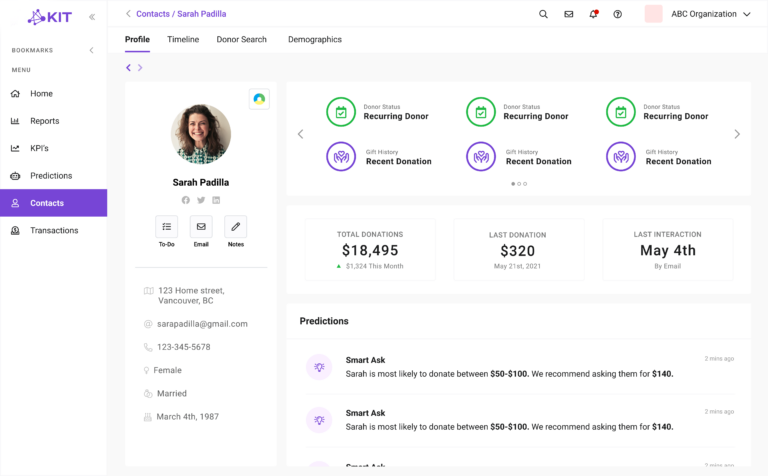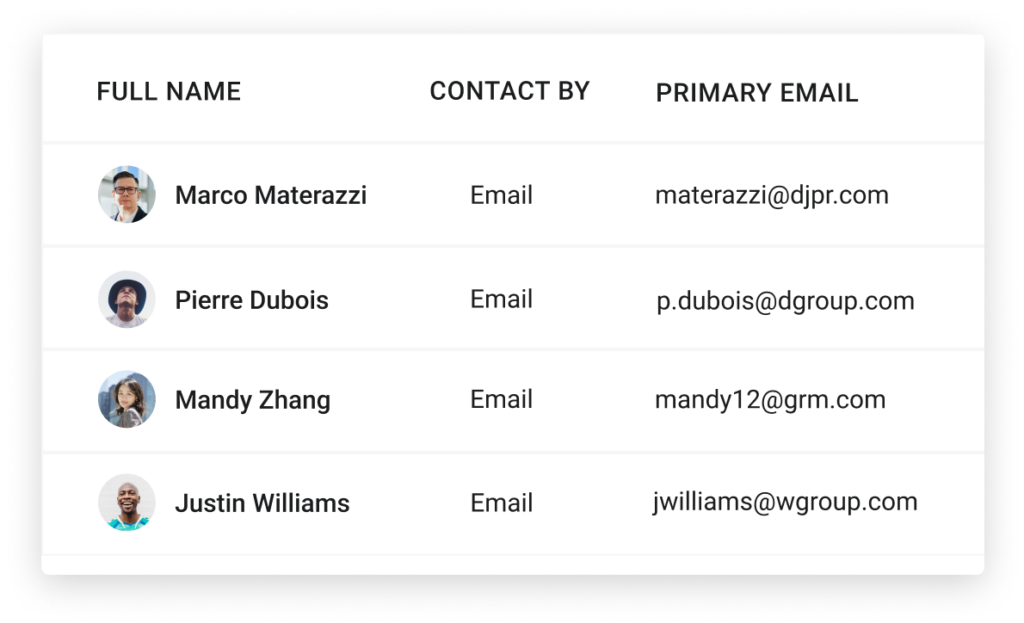What is data analytics, and how can it turn a good fundraising strategy into a great fundraising strategy?
Let’s start with a simple definition.
Data analytics is the science of studying data to make conclusions and predictions that guide decision-making. Further, fundraising data analysis is the process of analyzing donor data to optimize individual appeals and guide overall fundraising strategies.
This article will walk you through the benefits of fundraising data analysis and how you can take advantage of it to raise more for your cause.
Fundraising Data Analysis: The Basics
There are three main ways that data analytics can benefit fundraising:
- Identifying and visualizing opportunities: If you use a CRM, you already have more fundraising opportunities than you realize. By analyzing your data, you can recognize patterns that highlight your most valuable opportunities. This way, you can always know which supporters you should reach out to next, which donors are at risk to stop giving, and which prospects have the greatest giving capacity.
- Optimizing your ask: How do you know you’re getting each appeal right? Again, this is where data analytics can help. Every donor has underlying giving patterns determined by their giving histories and their interactions. Data analysis can identify these patterns to make accurate donor predictions about how much you should be asking for or when a donor is ready to become a monthly donor.
- Guiding and prioritizing your day to day work: As a fundraiser, understanding where to prioritize your efforts gives you a huge advantage. Who should you focus on today? How should you reach out? Can you segment donors for more personalized communications? Data analytics can answer these questions for you.
Fundraising data analysis can take your fundraising to the next level and help you stand out in your role.
Start Segmenting Your Donors
Use this FREE Donor Segmentation Template to segment your donors and contacts based on their level of engagement.
What Nonprofits Can Learn from For-Profit Data Analytics
Unfortunately, data analysis tools haven’t always been readily available in the nonprofit sector.
However, a technological revolution has finally come to the nonprofit sector, with fundraisers being the first nonprofit professionals to embrace data analytics.
Additionally, I’d like to suggest that the nonprofit sector should learn from the for-profit adoption of analytics. Thousands of businesses have already performed data analyses, and hundreds of studies have reported their results. We can learn from what they did to understand the implications of our data more quickly.
So, what does data analytics do well for businesses?
McKinsey reported that there are four main areas where data analytics had the most value to businesses:
- Lead generation & lead scoring
- Customer lifetime value maximization
- Pricing
- People management
Let’s translate these into nonprofit-specific applications:
- Donor prospecting & donor scoring
- Donor lifetime value maximization
- Optimizing the ask
- Fundraising performance management
McKinsey reported that one organization even analyzed which sales leads were converting the best; they shifted their focus to these leads and raised conversion rates by 30%.
Imagine if your donor conversion rate jumped up by 30%! These are not just small, incremental benefits. By looking at how businesses have embraced analytics for their own benefit, you can identify methods by which to increase your average gift size and overall fundraising success.
Let’s unpack these methods further.
4 Ways Fundraising Data Analysis Benefits Nonprofits
1. Donor prospecting & donor scoring
Fundraising data collection and analysis can help fundraisers perform prospect scoring, wealth screening, and prospect research quickly and more accurately.
There are a few excellent data-driven prospecting tools on the market like Windfall, DonorSearch, and WealthEngine. These tools will look at various wealth indicators like real estate ownership, stock holdings, business affiliations, and political giving to determine a prospect’s giving capacity.
These tools can also assign scores to prospects based on their likelihood to give to your organization.
Additionally, Fundraising KIT integrates with leading wealth screening tools and automatically updates donor profiles to alert you when contacts in your current donor database are likely to become monthly or major gift donors.
You can then sort these contacts and set up fundraising campaigns to manage targeted appeals. With Fundraising KIT, you can create a more personalized outreach strategy and improve your donor conversion rates.

2. Donor lifetime value maximization
One of the best ways to utilize fundraising data analytics is to nurture and cultivate donor relationships. By studying various fundraising metrics you can evaluate your donor relationship management strategy and how well you solicit donations.
For example, by studying the metric Donor Lifetime Value, you can understand how long, how much, and how frequently the average donor gives to your organization.
By seeing this metric change over time you can understand whether or not your relationship building strategies are successful in improving the retention rate of your donor base and motivating donations.
Download Our FREE Donor Lifetime Value Calculator
Donor Lifetime Value (DLTV) measures the amount an average donor contributes throughout their relationship with your nonprofit. With this calculator, you can understand the impact of donor engagement and boost your fundraising ROI!
3. Optimizing the ask
How and when you reach out to a donor can determine how successful your appeal will be. If you know when a donor is most likely to give, you can reach out at the perfect time and ask for precisely the right amount.
Data analytics tools like Fundraising KIT can provide donor insights to help increase fundraising success. For example, KIT’s Best Way To Reach Out feature provides you with the communication method a donor is most likely to respond to. This feature helps you communicate with each donor using their preferred method and increase the chances of a successful appeal.

4. Fundraising performance management
Nonprofits are made up of brilliant individuals who choose to dedicate their time to the causes they believe in. However, they still need management and training.
Tools like Gong.io are revolutionizing sales training by monitoring sales conversations and crunching the data to make suggestions like “talk less about x” or “don’t mention discounts so often.”
Imagine if you received an email each week describing how you could improve your donor conversion rate based on the analysis of your email and phone calls. This is what Gong provides, and it’s a powerful example of fundraising data analysis.
Other software focuses on HR data analysis looking at employee engagement, cost per hire, turnover rates, and gender pay equality. Also, software like OrgVue and ChartHop focus on HR Analytics and provide powerful tools for any organization that want to grow their team and create more impact.
Most large nonprofits are using fundraising analytics to guide strategy. The question is whether you, as a fundraiser, are at the stage where data analytics gives you the competitive advantage you are seeking.
So, consider the growth opportunities listed in this article, and if your organization is ready to raise more and create more impact, learn more about how to take your next step with fundraising data analysis.

Talk to a fundraising expert today to learn more about how Fundraising KIT can quickly and easily help your nonprofit raise more for your cause.

Stephen O’Neill
Marketing and Partnerships Manager at Fundraising KIT
Passionate about exploring and learning, Stephen has spent the past number of years working across marketing teams in Canada, Australia, and his native Ireland. Stephen has worked in, and written content for, a multitude of industries including the nonprofit, investment, and financial services sectors.
Away from the desk, Stephen can usually be found snowboarding in winter, camping in summer, bingeing new Spotify playlists, and touring new destinations whenever possible.







